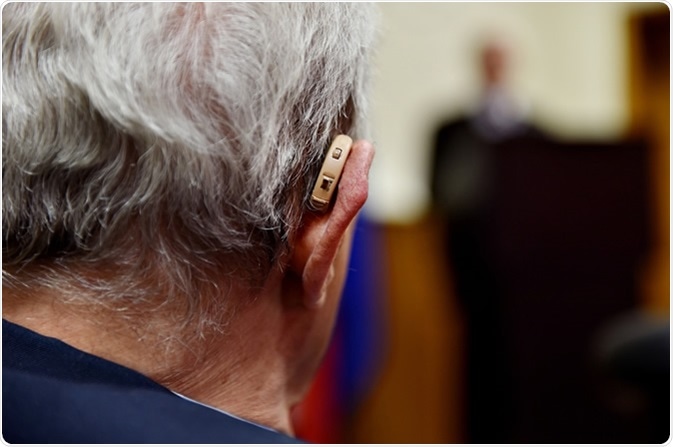Hearing loss is a state of partial or complete inability to hear.

Image Credit: roibu / Shutterstock
Causes
This condition affects people of all ages and can be genetic, developmental, congenital, or a sudden occurrence. Sensorineural and conductive are the two broad classifications of hearing loss. Many factors such as malfunction of parts inside the ear, aging, and exposure to loud noise can cause hearing loss.
Treatments
Hearing loss is often an irreversible condition and for the rehabilitation of patients with hearing loss, there are limited resources available for its treatment. Hearing aids and implants are the most common options for rehabilitation.
Current research
Scientists and doctors all over the world are therefore conducting various research projects to discover the reasons behind the condition and investigate possible cures for this ailment.
Most modern research is based on gene therapy and stem cells. Although these dominate research in the area of hearing loss, other areas of interest include the discovery of proper drugs, as well as the study of hearing loss as a complication of other diseases.
Research: Gene Therapy
In 2005, gene therapy was experimented on guinea pigs to cure deafness. This therapy was found to promote the regrowth of hair cells that recorded sound in the cochlea. This experiment gave hope for the development of the same procedure in humans.
In 2008, a similar method was used in mice, in which in utero gene transfer of Atoh1 initiated the growth of functional auditory hair cells in the cochlea. These new hair cells were capable of mechanoelectrical transduction. The researchers found that the controlling of the fate of the cell by misexpression of the transcription factor can produce functional sensory cells in the cochlea of mammals.
Using gene therapy for hearing loss
Experimentation with a transgenic mouse line that expressed human SLC26A4 was conducted in 2013 to study hearing loss due to the enlargement of the vestibular aqueduct. The study proved that to restore the normal inner ear function, restoration of pendrin to the endolymphatic sac is sufficient.
In a study conducted in 2015, the transmembrane channel (TMC) was used to investigate whether genetic hearing loss is curable. To this end, TMC helped to restore the auditory functions in mice, suggesting the possibility of development of the same strategy for the restoration of deaf patients with the TMC1 mutation.
At Columbia University, the Departments of Otolaryngology and Head and Neck Surgery are conducting one of the world's first gene therapy trials for hearing loss in men. In this experiment, an investigational drug that contains a gene is used for the regeneration of cells.
Research: Stem cells
The Massachusetts Eye and Ear Infirmary in Boston, Massachusetts in the United States has completed a study in regrowing the hair cells using embryonic stem cells. The natural development of the hair cells was accelerated by exposing chemical factors to the embryonic cells. These cells, when induced into chicken embryos continued to grow as the natural hair cells produced in the embryo.
The first study of whether stem cells can reconnect the inner ear to the brain was performed in 2012. Dubbed otic neural progenitors (ONPs) formed by adding fibroblast growth factors to human embryonic stem cells were transplanted to the ears of gerbils and were treated with a chemical that damages the auditory nerve. Some transplanted cells successfully grew projections that formed connections to the brain stem weeks after transplantation.
Another research project has been performed by scientists at the Harvard Stem Cell Institute (HSCI) which involves the development of techniques that will help to grow hair cells in the laboratory so that they can be implanted into the ear. In other experiments, HSCI researchers also found that stem cell-derived auditory neurons will form new connections with damaged hair cells.
Related research
- “Changes in the adult vertebrate auditory sensory epithelium after trauma” is a study that evaluates the characteristics and repair capabilities of traumatized auditory sensory epithelium in the adult vertebrate ear.
- Research done by the Massachusetts Institute of Technology in February 2017 revealed a combination of drugs that can regenerate hair cells.
- “Acquired hearing loss and brain plasticity” is a study conducted in 2016 by the University of Calgary, Canada. It is based on noise-induced hearing loss and the effects of trauma in the brainstem.
- Health Foundation in New York is an eminent institution that conducts many studies related to hearing loss. During 2000–2014, they have done more than 40 studies on different areas related to hearing loss. It includes studies of disorders, implants, hair cell regeneration, etc.
The list of major studies is given below:
References
Further Reading
Last Updated: Nov 2, 2022